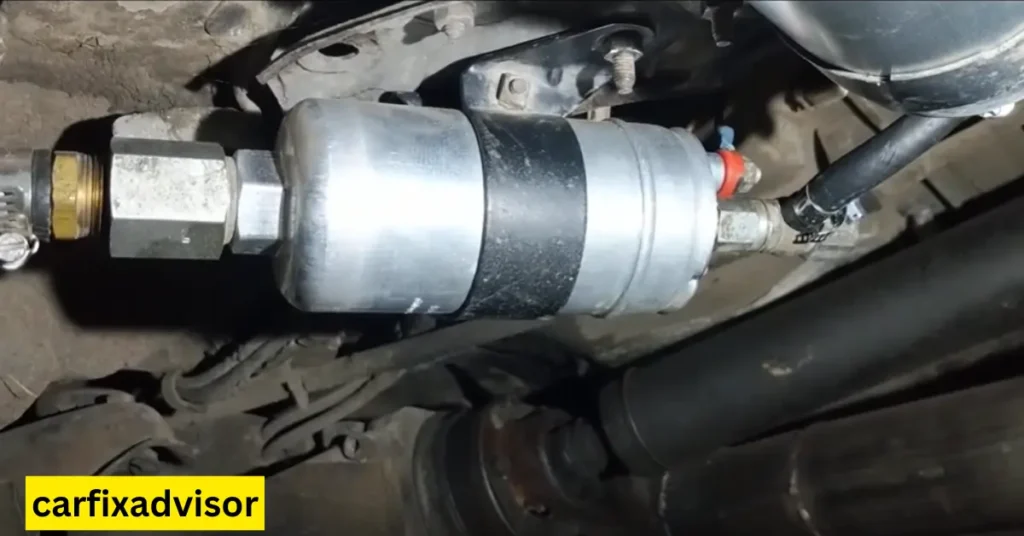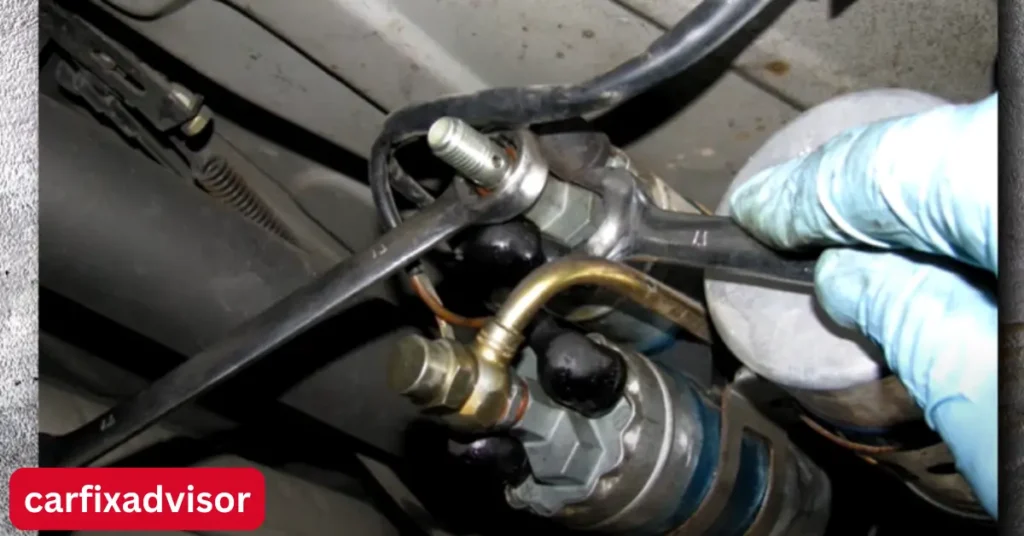Driving a vehicle depends on many systems working in perfect coordination, and the fuel pump is one of the most essential components of the fuel system. When this part stops functioning, it can quickly turn a normal drive into a stressful situation. What happens when fuel pump goes out while driving can include sudden power loss, engine sputtering, or the vehicle stalling altogether. Knowing how the fuel pump operates and understanding the warning signs of failure can help you stay calm, react safely, and reduce potential damage or danger on the road.
In this article, we’ll dive into what happens when the fuel pump goes out while driving, how to identify signs of a failing fuel pump, and how to handle the situation safely. We’ll also explain what you can do to prevent fuel pump failure from affecting your driving experience.
What is a Fuel Pump and Its Role in Your Vehicle?
The fuel pump is a vital component in any vehicle powered by liquid fuel. Its primary job is to move fuel from the gas tank to the engine, where it is mixed with air and burned for combustion. Without a functioning fuel pump, your engine wouldn’t receive the necessary fuel to run properly, leading to a range of performance issues or even complete engine failure.
There are two main types of fuel pumps:
Low-pressure fuel pumps – These are commonly found in vehicles with carburetors and typically operate under lower pressure (10-15 psi).
High-pressure fuel pumps – These are used in modern vehicles with fuel injection systems, operating at much higher pressures (up to 30,000 psi).
Electric fuel pumps are common in modern vehicles, while some older vehicles or specific machinery may use mechanical pumps. Regardless of the type, a failing fuel pump can disrupt the fuel delivery system and cause the engine to lose power or even stall completely.
What Happens When the Fuel Pump Fails While Driving?
When the fuel pump goes out while driving, the effects can range from mild to severe, depending on how far along the failure has progressed. Let’s take a closer look at what happens in such a situation.
1. Engine Stalls or Stops Running
One of the most common outcomes of a fuel pump failure while driving is an engine stall. The pump is no longer delivering the necessary fuel to the engine, causing it to sputter and eventually shut off. You may experience sudden loss of power while driving, especially on highways or busy roads. The car may fail to restart immediately, leaving you stranded in traffic or in an unsafe area.
What Happens:
As the pump fails, the engine is deprived of fuel.
The engine sputters, slows down, and eventually stops running.
You may experience difficulty starting the car after the pump fails.
2. Inability to Accelerate
If the fuel pump begins to fail gradually, you might notice a decrease in engine power, particularly during acceleration. The engine may hesitate or struggle to respond to the accelerator. This is because the pump is no longer providing a steady fuel flow to meet the engine’s increasing demand as you try to speed up.
What Happens:
The car might feel sluggish or unresponsive.
The vehicle may hesitate or lurch when you press the accelerator.
Acceleration may be rough or erratic, especially under heavy load or at higher speeds.
3. Poor Fuel Economy
A failing fuel pump can also lead to a decrease in fuel efficiency. If the fuel pump is working inefficiently, it might not be delivering the right amount of fuel to the engine. This inefficiency can cause the engine to burn more fuel than necessary, leading to poor gas mileage. You may notice that you’re refueling more frequently than usual.
What Happens:
The engine may burn excess fuel to compensate for the lack of proper fuel delivery.
The vehicle may consume more gas than usual, reducing overall fuel economy.
4. Strange Noises from the Fuel Tank
Another sign that the fuel pump is failing is unusual noises coming from the fuel tank. If you hear a whining or buzzing sound, it could be the fuel pump struggling to function. This noise often becomes louder as the pump wears out or begins to fail. If the noise persists, it’s important to address the issue immediately.
What Happens:
A whining, whirring, or buzzing sound emanating from the fuel tank.
The noise can indicate that the pump is working harder than normal due to wear and tear.
Early Symptoms of a Failing Fuel Pump
Before the fuel pump completely fails, you may notice certain early symptoms that can help you identify the issue. Catching the problem early can prevent a complete breakdown and give you time to address it before the situation worsens.
1. Difficulty Starting the Engine
A failing fuel pump may cause your car to take longer to start, especially if it’s struggling to deliver fuel to the engine. If you notice that the car takes longer than usual to crank up, or if it takes a few tries to start, it could be a sign that the fuel pump is on its way out.
What to Watch For:
Engine cranking longer than usual.
Difficulty starting the vehicle in cold or warm conditions.
2. Sputtering or Stalling at High Speeds
Another sign of a failing fuel pump is sputtering or stalling at higher speeds, especially when the vehicle is under load, such as when driving uphill or accelerating rapidly. If the fuel pump cannot provide enough fuel to meet the engine’s needs, the engine will sputter, hesitate, or stall completely.
What to Watch For:
The vehicle stutters or jerks, particularly at higher speeds.
The engine stalls unexpectedly when driving on the highway.
3. Decreased Acceleration or Power Loss
As the fuel pump’s performance declines, the engine may not receive enough fuel to maintain acceleration or power, particularly when you’re trying to accelerate quickly. The car may feel weak, sluggish, or fail to respond to pressing the gas pedal.
What to Watch For:
Poor acceleration when merging onto highways or overtaking other vehicles.
A noticeable lag in engine response when you press the accelerator.
4. Fuel Gauge Reading Incorrectly
A faulty fuel pump can also cause the fuel gauge to give incorrect readings. If the fuel pump isn’t working properly, it may not correctly sense the fuel level in the tank, leading to inaccurate readings on your dashboard.
What to Watch For:
The fuel gauge may indicate more or less fuel than actually in the tank.
The fuel light may come on prematurely or not turn off when the tank is full.
What to Do if the Fuel Pump Fails While Driving
If you experience a fuel pump failure while driving, it’s crucial to stay calm and take the following steps to minimize risks and keep yourself safe:
1. Pull Over to the Side of the Road
If your vehicle starts to stall or lose power, safely guide the car to the side of the road. Make sure to park in a safe location, such as a shoulder or parking lot, away from traffic. Avoid trying to restart the car or drive further until you’ve assessed the situation.
2. Turn on Your Hazard Lights
Once your vehicle is safely off the road, turn on your hazard lights to alert other drivers of your presence. This is especially important if you’ve pulled over in a busy area or on the highway.
3. Call for Roadside Assistance or a Tow
If you’re unable to restart the car or the engine won’t run smoothly, call for roadside assistance or arrange for the car to be towed to a mechanic. A professional will be able to diagnose the issue and determine whether the fuel pump needs to be replaced or if there are other contributing factors.
4. Avoid Attempting to Drive Further
Trying to drive your vehicle with a failing fuel pump can cause further damage to the engine and other fuel system components. If the fuel pump has completely failed, continuing to drive could lead to a complete engine shutdown or even a more costly repair.
Diagnosing and Handling Fuel Pump Failure While Driving
In the previous section, we discussed what happens when the fuel pump goes out while driving, and how to identify the early signs of a failing pump. Now, let’s focus on diagnosing the issue, understanding the potential consequences of continued driving with a faulty fuel pump, and exploring practical solutions.
Diagnosing a Fuel Pump Failure
If you suspect that your fuel pump is on the verge of failing, it’s essential to diagnose the problem accurately. Diagnosing a faulty fuel pump as early as possible can save you from costly repairs and ensure your safety while driving.
1. Fuel Pressure Test
A fuel pressure test is the most reliable way to determine if your fuel pump is working correctly. It involves measuring the pressure at the fuel rail using a special gauge. The fuel pump is responsible for delivering a specific amount of pressure to the engine, and if the reading falls below the required level, it indicates that the pump is failing.
Steps to Perform a Fuel Pressure Test:
Locate the fuel pressure test port (usually located on the fuel rail).
Connect a fuel pressure gauge to the test port.
Turn the ignition to the “on” position (don’t start the engine) and observe the reading on the gauge.
Compare the reading to the manufacturer’s recommended fuel pressure. If it’s lower than expected, the fuel pump may need to be replaced.
2. Checking for Noise from the Fuel Tank
As we discussed earlier, a whining or buzzing sound from the fuel tank could be a sign of a failing fuel pump. While the fuel pump does make some noise during normal operation, any unusual or loud noise is a red flag. The noise may become more noticeable as the pump struggles to supply fuel, especially if it’s clogged or malfunctioning.
What to Do:
Listen carefully when you turn on the ignition (before starting the engine). You should hear a soft humming noise coming from the fuel tank.
If the noise is unusually loud or whining, it may indicate that the pump is struggling to function properly.
If this sound persists or worsens, it’s best to have your fuel pump inspected by a mechanic.
3. Fuel Filter Inspection
If your fuel pump is failing, the fuel filter might also be clogged or dirty, restricting fuel flow. A clogged filter puts additional strain on the fuel pump and can lead to poor performance. Before jumping to conclusions, always check the fuel filter to ensure it’s not the cause of the fuel delivery issue.
Steps to Check the Fuel Filter:
Locate the fuel filter, typically near the fuel tank or along the fuel line.
Check the filter for dirt, debris, or signs of blockage.
If the filter is clogged, replace it and test the vehicle again.
What Happens If You Drive with a Faulty Fuel Pump?
Driving with a failing fuel pump is not advisable, as it can lead to a range of performance issues and even cause additional damage to your engine. Here’s a breakdown of what can happen when you continue to drive with a broken or malfunctioning fuel pump.
1. Complete Engine Shutdown
The most severe consequence of driving with a failing fuel pump is that the engine may shut down completely. The fuel pump’s job is to supply fuel to the engine. If it can’t do this effectively, the engine will run out of fuel and stall. This can happen unexpectedly, leaving you stranded on the road.
Consequences:
Complete engine loss of power, often happening at high speeds or while overtaking.
Difficulty restarting the engine, and potential inability to restart at all.
2. Damage to the Engine
Continued driving with an inadequate fuel supply can cause significant damage to the engine. Without proper fuel pressure, the engine may run too lean (too much air, too little fuel), which can lead to overheating, misfires, or even engine knocking. This can result in costly repairs, especially if the damage affects the pistons, valves, or the overall combustion process.
Consequences:
Potential engine overheating due to improper combustion.
Internal damage from running too lean, which could lead to warped valves or damaged pistons.
3. Increased Risk of Safety Hazards
A failing fuel pump can also pose safety risks while driving. If the engine stalls unexpectedly, particularly on highways or busy roads, it can lead to accidents or rear-end collisions. It’s crucial to address a faulty fuel pump before it puts your safety at risk.
Consequences:
A sudden stall in heavy traffic or on the highway increases the risk of a collision.
Loss of power steering and braking in some vehicles could make the situation even more dangerous.
How to Handle Fuel Pump Failure While Driving
If your fuel pump starts failing while driving, it’s essential to stay calm and take immediate action. Here’s what you should do in the event of a fuel pump failure:
1. Pull Over Safely
If you notice symptoms such as sputtering, a decrease in power, or engine stalling, pull over to the side of the road as soon as it’s safe. It’s critical to move to a safe location, away from heavy traffic, before the engine stalls completely. Use your hazard lights to alert other drivers of your situation.
Action Steps:
Slow down and look for a safe area to pull over.
Engage your hazard lights immediately.
Avoid panic; safely maneuver your vehicle to the side of the road.
2. Turn Off the Engine
Once you’ve safely pulled over, turn off the engine and avoid trying to restart it immediately. This will prevent further damage to the fuel system and give you time to assess the situation. It also ensures that the electrical components aren’t further stressed.
3. Call for Help
If your vehicle has stalled and isn’t restarting, it’s time to call for roadside assistance or a tow truck. Explain the symptoms you’ve observed to the dispatcher to help them understand that you may be dealing with a failing fuel pump. A professional mechanic will be able to assess the situation and perform the necessary repairs.
What to Do:
Call for roadside assistance or arrange for towing to the nearest mechanic.
If you’re stranded in an unsafe location, make sure to wait inside your vehicle with your seatbelt on.
4. Don’t Attempt to Drive Further
If your car stalls due to a fuel pump failure, do not attempt to restart and drive the vehicle again, as doing so could cause further damage to the engine and other components of the fuel system. It’s best to leave the vehicle for professional inspection.
Preventing Fuel Pump Failure
While fuel pump failures can sometimes be sudden, there are steps you can take to reduce the risk and extend the life of your fuel pump.
1. Regular Fuel System Maintenance
Regularly servicing your vehicle’s fuel system, including the fuel filter, fuel lines, and fuel injectors, can help prevent premature fuel pump failure. A clogged fuel filter can put unnecessary strain on the pump, leading to premature failure. Replacing the filter at regular intervals ensures smooth fuel delivery.
2. Don’t Run Low on Fuel Too Often
Avoid letting your fuel tank run near empty regularly. When you drive with a low fuel level, the fuel pump starts drawing in air and debris from the bottom of the tank. This can cause the pump to overheat and lead to faster wear.
3. Use High-Quality Fuel
Using low-quality fuel can lead to sediment buildup in the fuel system, which can clog the fuel pump or the fuel filter. Always use high-quality fuel from reputable sources to maintain the health of your fuel system.
Conclusion
When the fuel pump goes out while driving, it can cause serious disruptions in vehicle performance, from stalling to poor acceleration and fuel economy. Recognizing the symptoms of a failing fuel pump early can help you take action before the problem becomes severe. If you do experience a fuel pump failure while driving, follow the steps to stay safe, and call for professional assistance to address the issue.
Regular maintenance and addressing early signs of fuel pump problems can help extend the life of your vehicle’s fuel system and prevent costly repairs in the future. Keep an eye out for unusual symptoms and always trust your instincts when something feels off with your vehicle’s performance.


